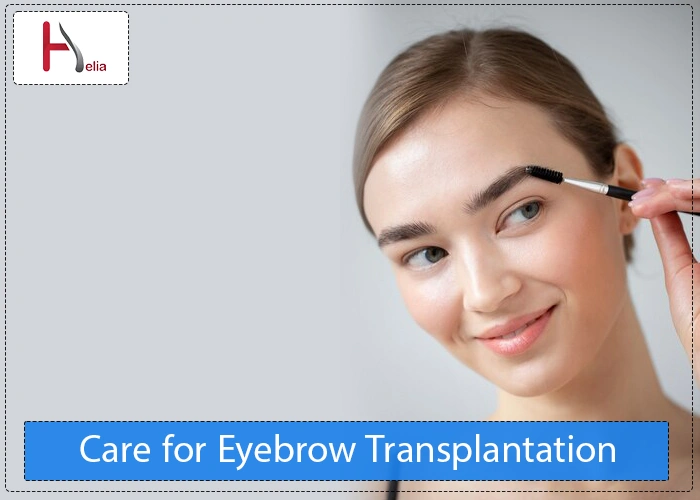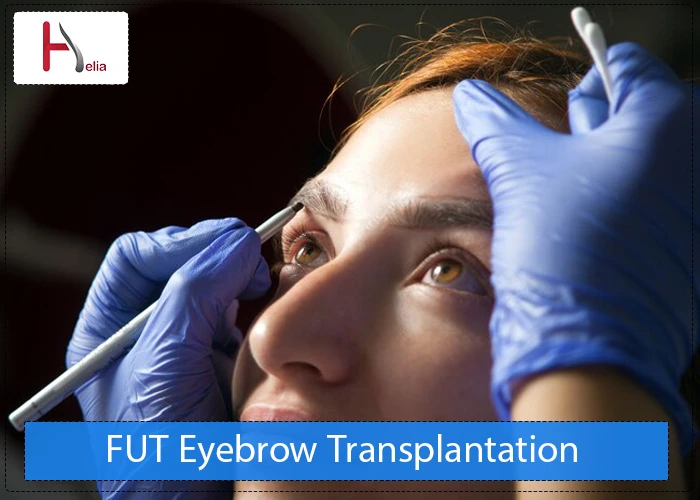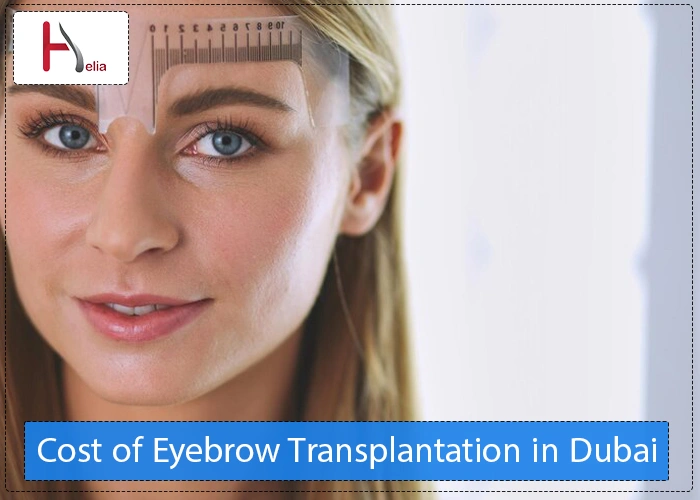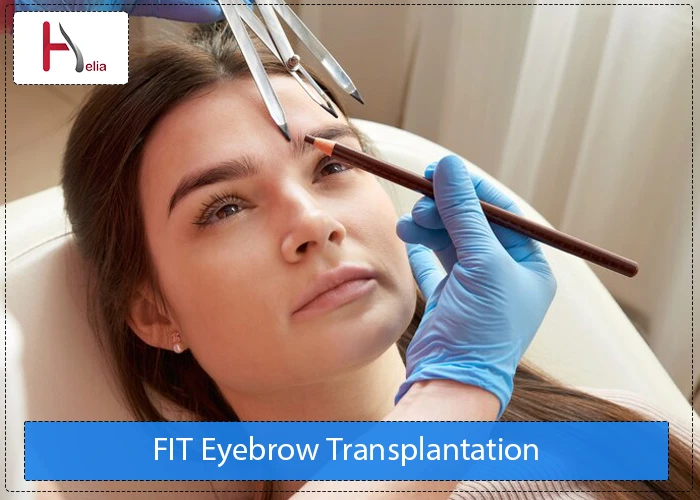To achieve the best possible results after eyebrow transplantation, certain sensitivities need to be taken into account. These include choosing a reputable and well-equipped clinic and a specialized and experienced physician. However, another crucial aspect that is often overlooked by individuals is the important post-care instructions after eyebrow transplantation.
Neglecting these instructions can jeopardize all your efforts and expenses. In this article, we aim to familiarize you, our valued Applicant, and loyal followers of Helia Specialized Hair and Eyebrow Transplantation Clinic, with the most important post-care tips in this regard. Join us in this article to achieve optimal results after undergoing eyebrow grafting.
To inquire about the cost of eyebrow transplantation, you can contact the consultants of Helia Specialized Skin and Hair Clinic for free by calling +971561004050. You can also reach us through WhatsApp at +971561004050 to ask any questions related to eyebrow transplantation and other beauty services.
How long should you avoid using cleansers after eyebrow transplantation?
You are probably aware that keeping the surgical site clean contributes significantly to the rapid healing of the wound. However, it is essential to know that washing the eyebrows after transplantation follows specific principles that should be discussed with your specialized physician. Each surgeon and eyebrow transplantation specialist may have specific guidelines for post-transplant eyebrow washing and recommend different time intervals for starting to use cleansers. Some suggest that individuals can begin washing after approximately 24 hours, while others recommend waiting three days after eyebrow grafting.
Although the use of normal saline follicle spray is performed every 2 to 3 hours to prevent the graft site from drying, washing the eyebrows is not recommended until 24 hours after the procedure.
During the first week, it is recommended to pour a small amount of shampoo or the cleansing agent recommended by your physician into lukewarm water and gently apply it to your eyebrows using a sterile gauze. After the seventh day, you can take a shower comfortably, but avoid applying excessive pressure or rubbing on the transplanted area. Twelve days after the grafting procedure, you are allowed to gently massage your eyebrows, and after 14 days, clean and scab-free eyebrows are expected.
For more information about the scabbing process after eyebrow transplantation, please refer to the relevant article.
| The Importance of Post-Care for Eyebrow Transplantation | Increasing the body's immune system strength and consequently accelerating wound healing. Accelerating body recovery rate. Preventing the severity of complications. Maintaining the results of eyebrow transplantation. |
| Washing the eyebrows after transplantation | Avoid sitting with the face down for up to 48 hours. Avoid applying pressure or rubbing the towel against the grafted area. Use appropriate cleansers. Use lukewarm water to wash the face. |
| Sleeping after eyebrow transplantation | Keep the head elevated above the body as recommended. Avoid sleeping on the stomach to prevent pressure on the eyebrows. |
| Nutrition after eyebrow transplantation | Eat fruits and vegetables. Drink enough water. Consume foods rich in unsaturated fatty acids. Consume foods rich in vitamins. |
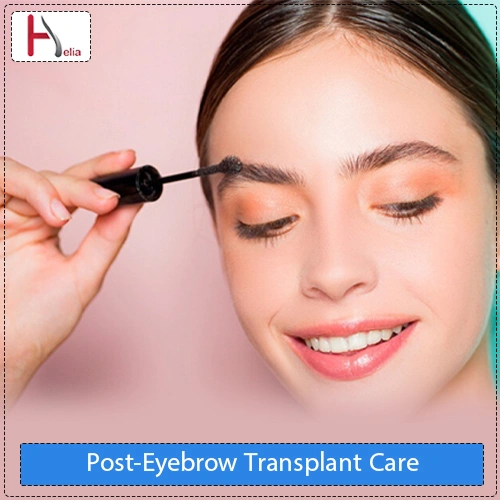
Post-Eyebrow Transplant Care
After eyebrow transplant surgery, the individual undergoing the procedure will have a relatively comfortable period, during which it is only necessary to observe some points. If we pay attention to certain conditions of eyebrow grafting and transplantation, we will see that this method will have permanent results. This means that with proper care and maintenance, natural eyebrow transplantation will beautify our faces for years to come. So, what should be done after a natural eyebrow transplant?
In this article, we will provide you with all the necessary information about this subject so that you can see the best possible outcome of the time and money you have invested in eyebrow transplantation:
Never expose yourself to direct sunlight!
One of the most important post-care recommendations after eyebrow transplantation is to avoid direct exposure to sunlight. The newly transplanted follicles are very weak in the early days, and harmful sun rays can damage them. For this reason, it is recommended to spend the recovery period at home as much as possible. If you have to go outside, be sure to use wide-brimmed hats.
Avoid water contact with the eyebrows
Water contact with the eyebrows during the first week can jeopardize all your efforts. Therefore, never wash your face or go to the bathroom for a few days after eyebrow transplantation.
Do not apply pressure to the eyebrows
Since the newly transplanted eyebrows have not yet adapted to their new environment and are very fragile, they should never be subjected to pressure. Any kind of pressure, such as scratching the transplanted area or being careless during washing, can damage the new follicles. Even when the specialist allows you to wash your eyebrows, you should not rub a towel against the eyebrow hairs.
Avoid using cosmetic and chemical products for a while
Another post-care after natural eyebrow transplantation is the prohibition of using cosmetic and chemical products until complete recovery. One of the most important aspects is refraining from coloring the eyebrows for one month after the transplant. After the recovery period, you can go back to using your desired products. However, it is still necessary to consult your doctor after this period. Also, continue to visit professional makeup artists who are more cautious in coloring and use high-quality dyes.
Avoid placing cold water compress on the eyebrows
Since after eyebrow transplantation, you will experience swelling and partial inflammation around the transplanted area, it is recommended to use ice compress to speed up the recovery process. However, if the compress is placed directly on the eyebrows, the follicles will be damaged. Put the ice pack in a cloth and use it exactly as instructed by the doctor.
Avoid smoking and alcoholic beverages
During the post-care period after eyebrow transplantation, it is recommended to never indulge in smoking and alcoholic beverages. Avoiding the use of these substances is mandatory, especially in the first week, as both can jeopardize the health of the transplanted eyebrows and prolong your recovery period. Tobacco reduces blood oxygen levels and causes a lack of oxygen in the transplanted follicles, while alcohol thins the blood and delays wound healing.
Avoid engaging in strenuous physical activities
If you have undergone natural eyebrow transplantation, you should refrain from engaging in strenuous physical activities and exercise for a while. These activities put pressure on the graft and the transplanted area. Additionally, physical activity leads to sweating, which in turn moistens the transplanted area. As mentioned before, water contact with the transplanted eyebrows in the first week can result in infection and other serious side effects. Read more about post-eyebrow transplantation complications.
Banned to pluck eyebrows
If you feel itching in the eyebrow area after the transplant, you should be careful not to scratch it under any circumstances. One of the points to consider about post-eyebrow transplant care is not to give any importance to the itching of your eyebrows.
The use of cosmetic products is not allowed for a while
Using cosmetic products may contaminate the treated area and cause infection. Therefore, until the doctor allows it, do not use cosmetic products.
Is it permissible to use Cerita after an eyebrow transplant?
Performing post-eyebrow transplant care has a significant impact on the durability and strengthening of the eyebrows after the transplant. This includes regular use of prescribed medications, following a dietary regimen, keeping the eyebrows clean and tidy, and using natural oils and certain eyebrow serums such as Cerita.
Cerita strengthening serum is one of the products made in our country, UAE, which can be easily used after an eyebrow transplant. This serum strengthens the newly transplanted hair roots and effectively supports their growth by providing nutrients to the cells. These products are recommended for individuals who have recently undergone eyebrow transplants due to their natural and herbal compositions. To learn how to use this product, it is best to contact our consultants at Helia Hair Transplant Clinic in Dubai and receive the necessary guidance.
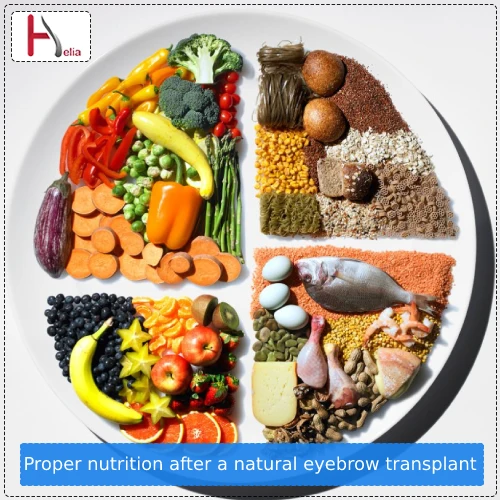
Proper nutrition after a natural eyebrow transplant
Nutrition is one of the influential factors in hair transplantation. Your diet directly affects the performance, quality, and growth of hair follicles. To have healthy hair follicles, the following nutrients should be present in your diet:
- Various vitamins: B vitamins, B7, and B12 play an important role in the structure, quality, and growth of hair. These vitamins support their nutritional metabolism by providing necessary nutrients to the newly transplanted follicles. That’s why doctors recommend using vitamin B complexes after an eyebrow transplant.
- Try massaging your eyebrows with very gentle circular motions a few days after the procedure.
- If the amount of iron and zinc in the person’s diet is sufficient, significant hair and eyebrow loss can be prevented. These substances also play an important role in tissue repair after natural eyebrow transplant and collagen production and cell division. Iron constitutes a significant part of collagen, which is a necessary protein for body tissues. For this reason, try to consume foods that contain iron or take iron supplements.
- Vitamin E is one of the essential nutrients needed for wound healing caused by transplantation and repairing damaged skin. This vitamin is found in foods such as almonds, avocados, spinach, sunflower seeds, etc. However, be careful if you are taking vitamin E supplements, inform the specialist before eyebrow transplant because vitamin E can thin the blood, and it may not be suitable for the transplanted area in the first two weeks. Therefore, the consumption of foods containing this vitamin should also be under the supervision of a specialist.
- By consuming vitamins such as vitamin C, you can help strengthen your immune system to heal wounds faster.
- Also, as much as possible, increase your water intake in your diet to enhance blood circulation in the body and better strengthen the follicles.
Post-eyebrow transplant care depends on pre-transplant care as well!
If you follow certain precautions before the eyebrow transplant, your eyebrow transplant will be successful with less pain, resulting in more beautiful eyebrows. Here are some points to consider before a natural eyebrow transplant:
- You should avoid taking any blood-thinning medications such as aspirin at least ten days before your eyebrow transplant.
- Avoid exposure to sunlight and stay away from its rays for three days before the natural eyebrow transplant.
- Have someone accompany you during the procedure because after the procedure, you should not drive, and it’s possible to be sensitive to anesthesia.
- Another step to improve post-eyebrow transplant care is to refrain from smoking at least one week before the surgery. Nicotine in tobacco causes blood vessel constriction and reduces blood flow, while carbon monoxide in smoke decreases the blood’s oxygen-carrying capacity, which may result in slower healing and potential infections. Many specialists recommend quitting smoking one month before and after the natural eyebrow transplant to ensure a higher success rate.
- On the day of your appointment with the doctor for the eyebrow transplant, wear button-up clothing to avoid putting pressure on your eyebrows during changing.
- Also, on the day of the procedure, have a light breakfast and avoid consuming beverages that contain caffeine, as these substances can increase bleeding.
- Refrain from plucking your eyebrows and avoid coloring them for 6-3 days before the procedure. In general, avoid any type of makeup and grooming on your eyebrows for a limited period.
Post-Eyebrow Transplant Care Tips for Optimal Results
To achieve the best results from your eyebrow transplant, it is crucial to give significant importance to post-transplant care. Some of these care tips include:
- If you experience severe pain that becomes unbearable, be sure to take pain medication.
- As part of post-transplant care, avoid direct exposure to the sun and, if you must go outside, wear a hat or a mask. Remember that hot weather can be detrimental to the transplanted eyebrows due to increased sweating, so it is strongly recommended to stay at home for a while.
- When allowed by the specialist, wash your face gently, avoiding the use of very hot water.
- Avoid using shampoos or cleansers that you previously used on your face, as the chemicals in them can be harmful to the transplanted follicles. Consult with a specialist for the appropriate cleanser. Ask common questions about eyebrow transplants from beauty experts at Helia Beauty Clinic.
- If you notice that the transplanted eyebrows start shedding after the procedure, do not worry as this is a natural phase, and they will regrow again.
- Once your eyebrows start growing and become longer, you can trim them two or three times a month to achieve a more desirable appearance. Use scissors to trim them.
- Many individuals do not experience any symptoms after the eyebrow transplant for at least a day. Therefore, it is worth mentioning that post-transplant complications do not occur for everyone.
- To prevent dryness in the transplanted eyebrow area, you can use vitamin A and D supplements as well as moisturizers like Vaseline.
- When taking a shower, it is better to divert the water flow away from your eyebrows using your hand, so they are not directly exposed to water pressure. However, our recommendation is to wash your head with a basin of water gently, allowing the water to flow over your eyebrows.
- Avoid swimming in pools for two weeks after the procedure, as the water and chlorine can damage the follicles.
- Until the transplant site fully heals, avoid vulnerable places such as saunas or tanning beds. Also, refrain from engaging in activities that cause excessive sweating.
- If you have long hairs, keep them away from the eyebrow line.
- Follow the instructions provided by your doctor regarding any creams or lotions they prescribe.
- Do not use any cosmetic or perfumed products for the first 2 to 4 hours after the natural eyebrow transplant.
Are stitches required after an eyebrow transplant?
In some cases, after an eyebrow transplant, there is no need to visit the doctor for stitch removal because absorbable sutures are used. However, if non-absorbable sutures are used, you should remove them yourself after 10 to 12 days to prevent infection. Always consult your specialist for guidance and ensure that all steps are performed under their supervision. The use of absorbable or non-absorbable sutures depends on the doctor’s diagnosis of your eyebrow transplant. You can discuss this matter with your specialist.
Removing stitches after an eyebrow transplant
The only method of eyebrow transplantation that involves surgery in the donor area is called FUT (Follicular Unit Transplantation). However, it is important to note that this is not a highly invasive procedure. Instead, the specialist creates a very thin strip in the donor area to extract a narrow strip of scalp skin with suitable follicles for transplantation in the eyebrow area. After removing this strip, stitches are required in the donor area to prevent bleeding and scar formation. The specialist will ask you to visit them within the time frame of ten days to two weeks to assess the wound’s condition.
If the stitches have healed well, and the wound is completely closed, the stitches will be removed after the eyebrow transplant. Otherwise, you should wait for the surgeon’s preferred time to remove the stitches. Rushing this process can lead to risks such as bleeding, infection, and the formation of large scars at the wound site.

The right time for eyebrow grooming
When an eyebrow transplant is performed, you will notice hair shedding around the third week, which is a natural occurrence known as shock shedding. At this stage, the hair has entered a resting phase. Afterward, the hair will regrow. Once the regrown eyebrow hair reaches a length of approximately 2 to 2.5 centimeters, the growth process will stop. However, if the specialist used hair from the donor area at the back of the head for the transplant, the grafted hair may continue to grow up to 3 or even 4 centimeters.
Therefore, you should groom your eyebrows once or twice a month. There is no need to worry; after some time, the hair strands will adjust to the growth pattern of the new area and, when they reach their normal length, their growth will also stop, bringing beauty to your eyebrows.
When can eyebrows be trimmed after an eyebrow transplant?
You may have recently undergone an eyebrow transplant, but the existing hair in the eyebrows has grown, and you need to trim them to avoid them becoming unruly. However, you must exercise caution because while trimming, you may damage the freshly transplanted follicles, causing them to shift or completely detach from the skin. In such cases, the transplanted eyebrows may become loose, or no hair will grow in the transplanted area.
For this reason, it is better to wait for one month before trimming your eyebrows after an eyebrow transplant to ensure there is no risk to the transplanted follicles. When performing the trimming, use a very suitable and sharp pair of scissors, as a dull blade may catch the hair strands and unintentionally damage the transplanted follicles.
Itching and Swelling after Natural Eyebrow Transplantation
One of the common side effects that individuals often experience after a natural eyebrow transplant is skin swelling and itching. The reason for swelling after the transplant is the manipulation of facial tissue, and itching starts when the wounds are healing. To help alleviate swelling and itching, you can use hydrocortisone cream. However, it is crucial to seek the advice of a specialist before using any medications.
Use of ointments after eyebrow transplantation
In general, using ointments is prohibited for up to one week after the transplant. Ointments are difficult to remove from the eyebrows due to their structure, disrupting washing. This can result in damage to the freshly transplanted follicles when washing. Some ointments have anti-inflammatory properties and can alleviate dryness.
You should consult with your physician and, if recommended, obtain the appropriate ointments. These may include tetracycline, clindamycin, and hydrocortisone. Additionally, some ointments have strengthening properties and, when used regularly, can prevent hair loss and promote thickening of the eyebrows. It is crucial not to use any medication without a doctor’s prescription. This is one of the most important post-care measures after an eyebrow transplant.
Pregnancy after eyebrow transplantation
In this regard, it is always important to determine restrictions and the best timing for hair transplantation by a dermatologist and hair transplant surgeon. The relevant physician will choose the best hair transplant technique based on individual needs and medical history.
Most dermatologists and hair specialists recommend postponing hair transplantation until after the period of pregnancy. If a prospective patient plans to become pregnant shortly after the hair transplant, the procedure may not be considered effective or advisable. Many women experience significant hair shedding during pregnancy, and hormonal changes resulting from pregnancy can affect the results of a natural eyebrow transplant.
Is eyebrow transplantation possible during breastfeeding?
You have completed your pregnancy, and your child is now in your hands. However, you are not satisfied with the shape of your eyebrows, and it is affecting your appearance. Is it safe to undergo an eyebrow transplant now?
Eyebrow transplant specialists have doubts about this. The reason for this uncertainty is that if you undergo an eyebrow transplant during breastfeeding, there is a risk of transferring antibiotics through breast milk to your child. Therefore, it is best to wait for at least one year after childbirth for hair transplantation.
Why is it important to follow medical recommendations?
Following medical recommendations after an eyebrow transplant is crucial because they play a significant role in achieving the final desired results. If the individual does not pay attention to post-transplant care, they may experience complications such as infection. It is recommended to have the doctor’s office number handy for emergencies, but we can assure you that by following all hygiene measures and choosing a reputable beauty clinic, you will not experience any problems regarding post-eyebrow transplant complications.
Furthermore, if the individual’s diet is not suitable, the follicles gradually weaken and may be lost after the eyebrow transplant. As a result, the person will need to revisit beauty centers for repair and incur additional expenses. Lastly, it should be noted that in eyebrow transplantation, in addition to factors such as the beauty center you visit, the skill and experience of the specialized physician also play a crucial role.
Your role in adhering to post-operative care for eyebrow transplantation is undeniable and has a significant impact on the success of the procedure.
Some individuals may have general health issues or conditions such as high blood pressure or insulin sensitivity, which can lead to eyebrow shedding. Therefore, it is necessary to be aware of the post-transplant care for natural eyebrow transplantation before deciding to undergo the procedure. Additionally, after the eyebrow transplant, you may experience an imbalance due to the use of sedatives, so it is important to have someone accompany you. Remember, you will be in control of matters after the surgery, so by following hygiene practices, dietary guidelines, and specific recommendations, you can increase the success of the procedure.
You can visit “Helia Skin and Hair Clinic” and consult with experienced specialists in the clinic to get information about the cost of eyebrow transplantation. For consultation, you can contact them at +971561004050.
Hair and eyebrow transplantation in this clinic is performed by a renowned physician in the country, Dr. Hamidreza Khorasani.

